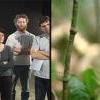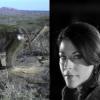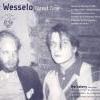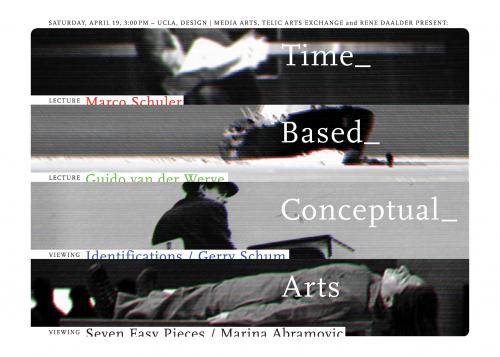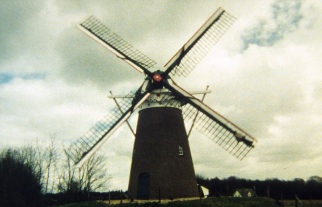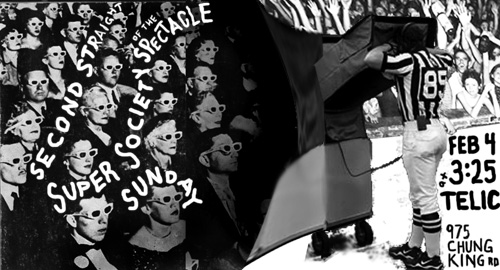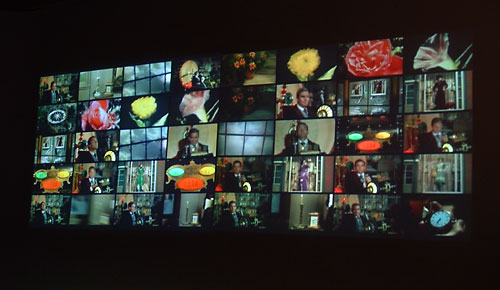Rachel Mayeri: Primate Cinema
May 3, 2008 12:00 pm to June 22, 2008
Field Station Hollywood: May 3 - May 29
Primate Cinema Exhibition: June 11 - June 22
Talk and Screening: May 24 at 6pm
Opening Reception: June 14 at 6pm.
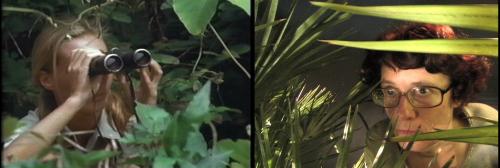
Primates and their on-screen dramas are the subject of an exhibition presented at TELIC Arts Exchange by Los Angeles artist Rachel Mayeri.
The exhibition is an installation of several video experiments on the human animal, including “Jane Goodall and the Wild Chimpanzees,” “How to Act like an Animal,” and “Baboons as Friends.”
In the video series “Primate Cinema,” Mayeri transforms TELIC Arts Exchange into an observation platform for viewing the social, sexual and political behavior of human and nonhuman primates.
Mayeri’s work enables viewers to observe human nature at a safe distance through the lenses of primatology and media studies.
Jane Goodall and The Wild Chimpanzees (10 minutes, 2008)
A live performance of a nature documentary, “Jane Goodall and The Wild Chimpanzees” was developed and videotaped during a three week workshop at TELIC in May. The edited video explores what it means to be animal, and how documentary dramatizes nature. The performers are: Suzan Averitt, Claire Cronin, Penny Folger, Estela Garcia, Dave Johnson, Diane Lefer, Adam Overton, and Joe Seeley.
How to Act like an Animal (5 minutes, 2008)
This video is one of several exercises from the “How to Act like an Animal” workshop, which was co-led with primatologist Deborah Forster and physical theatre director Alyssa Ravenwood. Through observation and imitation of a nature documentary, human performers play chimpanzees–hunting, killing, and sharing the meat of a colobus monkey.
Baboons as Friends (6 minutes, 2007)
The first of the “Primate Cinema” series, “Baboons as Friends,” translates a primate social drama for human audiences. A two-channel installation, “Baboons as Friends” juxtaposes field footage of baboons with a reenactment by human actors, shot in film noir style. A tale of lust, jealousy, sex, and violence transpires simultaneously in human and nonhuman worlds. Beastly males, instinctively attracted to a femme fatale, fight to win her, but most are doomed to fail. The story of sexual selection is presented across species, the dark genre of film noir re-mapping the savannah to the urban jungle.

Field Station Hollywood
Primate Research Laboratory and Performance Workshop
Ongoing in May at TELIC Arts Exchange
In May, TELIC Arts Exchange will be a laboratory for primate research and video production, and will be open to visitors. As part of TELIC’s Public School, Mayeri will lead a workshop on “How to Act like an Animal.” The workshop will explore primate social structure, communication, and movement in a series of performative experiments, with contributions by primatologist Deborah Forster. The workshop will form the basis for a video to be shot at TELIC Arts Exchange in May and screened in June as part of Primate Cinema. Participation in the free workshop, offered as part of TELIC’s Public School, is limited to 15 people. To inquire, please follow the link below:
http://thepublicschool.org/105/how-to-act-like-an-animal/
Primate Cinema:
Baboons as Friends
The first of the “Primate Cinema” series, “Baboons as Friends,” translates a primate social drama for human audiences. A two-channel installation, “Baboons as Friends” juxtaposes field footage of baboons with a reenactment by human actors, shot in film noir style. A tale of lust, jealousy, sex, and violence transpires simultaneously in human and nonhuman worlds. Beastly males, instinctively attracted to a femme fatale, fight to win her, but most are doomed to fail. The story of sexual selection is presented across species, the dark genre of film noir re-mapping the savannah to the urban jungle.
“Baboons as Friends” was screened at the Museum of Contemporary Art in Denmark and received a Semifinalist honor for an International Visualization Competition sponsored by the National Science Foundation and the Journal Science. It was made in collaboration with primatologist, Deborah Forster, whose research and footage of wild baboons in Kenya is featured in the video. “Baboons as Friends” is played by actors Camillia Sanes, Patrick Mulderrig, Shaun Madden, Randy Tobin, and Andrew Maxwell. Liz Rubin, director of photography, captured their primate behavior in high definition video in a Chinatown bar.
http://www.soft-science.org/primate.html
Primatologists on Acting in the Animal Kingdom
Talk and Screening of “Primate Cinema: Baboons as Friends”
May 24, 6 PM, TELIC Arts Exchange
On May 24, primatologists Deborah Forster and Rebecca Frank will give talks, followed by a screening of “Primate Cinema: Baboons as Friends.” Deborah Forster has worked with primates at the San Diego Zoo, and researched wild baboons in Kenya. Forster’s talk will be on the how and why of acting and motor mimicry in the animal kingdom, examining videos of “walking” octopuses, painting elephants, and aping orangutans. Dr. Frank, who researches female social behavior and cooperation, will analyze the group dynamics of a Reality TV show.
Rachel Mayeri
Rachel Mayeri is a Los Angeles-based artist working at the intersection of science and art. Her videos, installations, and writing projects explore topics ranging from the history of special effects to the human animal. Videos include “Stories from the Genome: An Animated History of Reproduction,” animations for “Biospheria: An Environmental Opera,” and “The Anatomical Theater of Peter the Great.” Mayeri programmed the anthology “Soft Science,” distributed by Video Data Bank, and her essay “Soft Science: Artists’ Experiments with Science Documentary” is published in Tactical Biopolitics: Art, Activism, and Technoscience (MIT Press, 2008). Her videos have shown at Pacific Film Archive, The Center for Art and Media in Germany, and P.S.1 in New York. The recipient of grants from Creative Capital Foundation, The Mellon Foundation, and California Council for the Humanities, Rachel Mayeri is a guest curator of the Museum of Jurassic Technology and Associate Professor of Media Studies at Harvey Mudd College.
http://www.soft-science.org/mayeri.html
The exhibition at TELIC is supported in part by a grant from the Durfee Foundation.
animals, camera, events, group identity, impersonation, projection, science, screening | Comments Off

